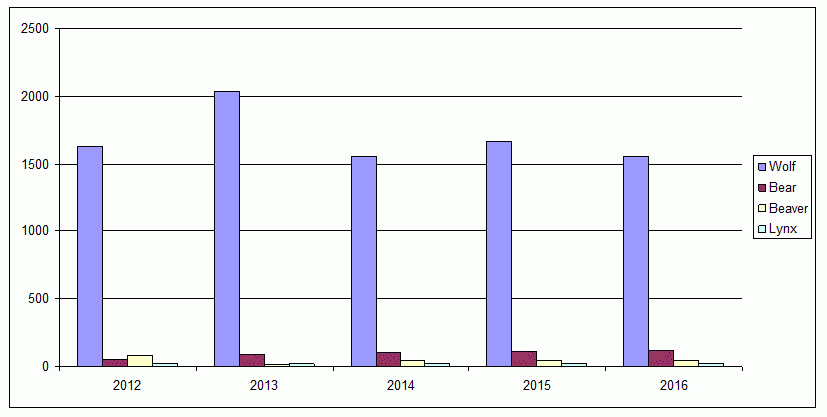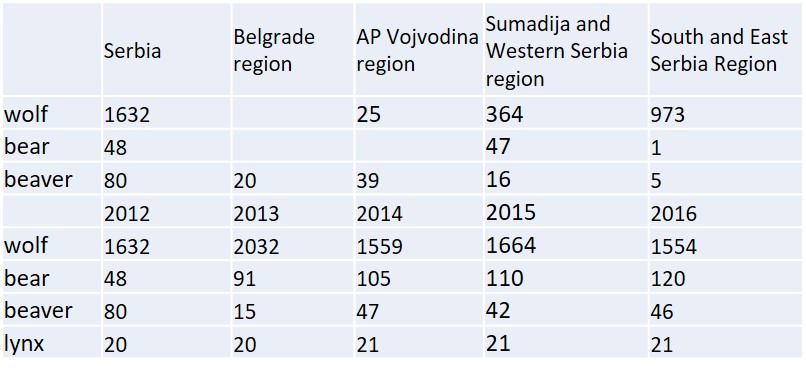Key message: In Serbia, in the last 5 years there has been a slight increase in the wolf population
Assessment: The first action plans for the management of large carnivores (grey wolf, bear and lynx) were done in 2007, pending adoption. Then new management programmes were prepared for bears and lynx in 2018, and in 2019 for the wolf. Data on the number of populations of large carnivores in Serbia are not harmonised. According to the data of the Forest Administration, the number of wolf population varies from 1600 to 2000; bear population at 50-120 with a marked increase in number; the population of lynx on 20-21, and the population of beavers at 40-80 with a downward trend.
However, according to expert estimates, the number of wolf population in Serbia is 800-1200. The population is divided into two sub-populations, Dinara-Balkan and Carpathian, and both populations have a stable and slightly upward trend. This estimate is based on a registered wolf catch in Serbia that has been in the range of 150-170 in the last 5 years, so if a five-year catch is observed, wolf population is estimated to be about 1000 individuals, with a slight increase in the population.

Indicator Name: Trend in the number of carnivorous mammal population
Institution/Author: Environmental Protection Agency/Slaviša Popović
Use and interpretation:
The indicator shows the size of populations of the selected carnivorous mammal species in the Republic of Serbia: beavers, wolf, bear and lynx
Key question(s) which indicator helps to answer
The indicator helps to answer the question: How does it look dynamic of populations of the selected carnivorous mammal species?
Use of indicator
Forest Directorate of the Ministry of agriculture collects data regarding population dynamics of the main hunting species: doe, boar, rabbit, pheasant, quail. Institute for Nature Protection collects data regarding wolf, bear and lynx.
Scale of appropriate use
The first action plans for the management of large carnivores (grey wolf, bear and lynx) were drafted in 2007, pending adoption. Then new management programs were prepared for bears and lynx in 2018, and in 2019 for the wolf. There are unharmonized data on the number of populations of large carnivores in Serbia. According to the data of the Forest Administration, the number of wolf population varies from 1600 to 2000. Bear population at 50-120 with a marked increase in number. The population of lynx counts 20-21, and the population of beavers at 40-80 with a downward trend.
Potential for aggregation:
Meaning of upward or downward trends (“good or bad”)
According to the data of the Forest Directorate, the size of wolf population is estimated at 2,032 specimens, bear population at 91, lynx population at 20, and beaver population at 15.
According to the data of the Institute for Nature Conservation, the size of wolf population ranges from 500 to 1400 specimens, the size of bear population did not exceed 53 specimens, population of lynx is reduced to several dozen specimens from the “eastern” sub-species and a couple of specimens of the “western” sub-species.
Possible reasons for upward or downward trends:
According to expert estimates, the number of wolf population in Serbia is 800-1200. The population is divided into two sub-populations, Dinara-Balkan and Carpathian and both populations have a stable and slightly upward trend. This estimate is based on a registered wolf catch in Serbia that has been in the range of 150-170 in the last 5 years, so if a five year catch is observed, the wolf population is estimated at about 1000 individuals, with a slight increase in the population.
Implications for biodiversity management of change in the indicator:
The indicator is presented as Biodiversity Indicator in 2015.
Units in which it is expressed:
The indicator is expressed in number of specimens.
Description of source data:
Forest Directorate, Institute for Nature Conservation of Serbia
Calculation procedure:
Number of samples
Most effective forms of presentation:
(graph types, maps, narratives, etc.-give examples where possible):
The best way to present this indicator is a graph.
Limits to usefulness and accuracy:
Delay in data exchanging with responsible Directorate and hunting associations. There are no exact and precious data regarding the size of some hunting population, because of inadequate methodologies applied.
Updating the indicator:
Data are updating annually.
Closely related indicators
Additional information and comments
Table: Data Trend in the number of carnivorous mammal population

Serbia